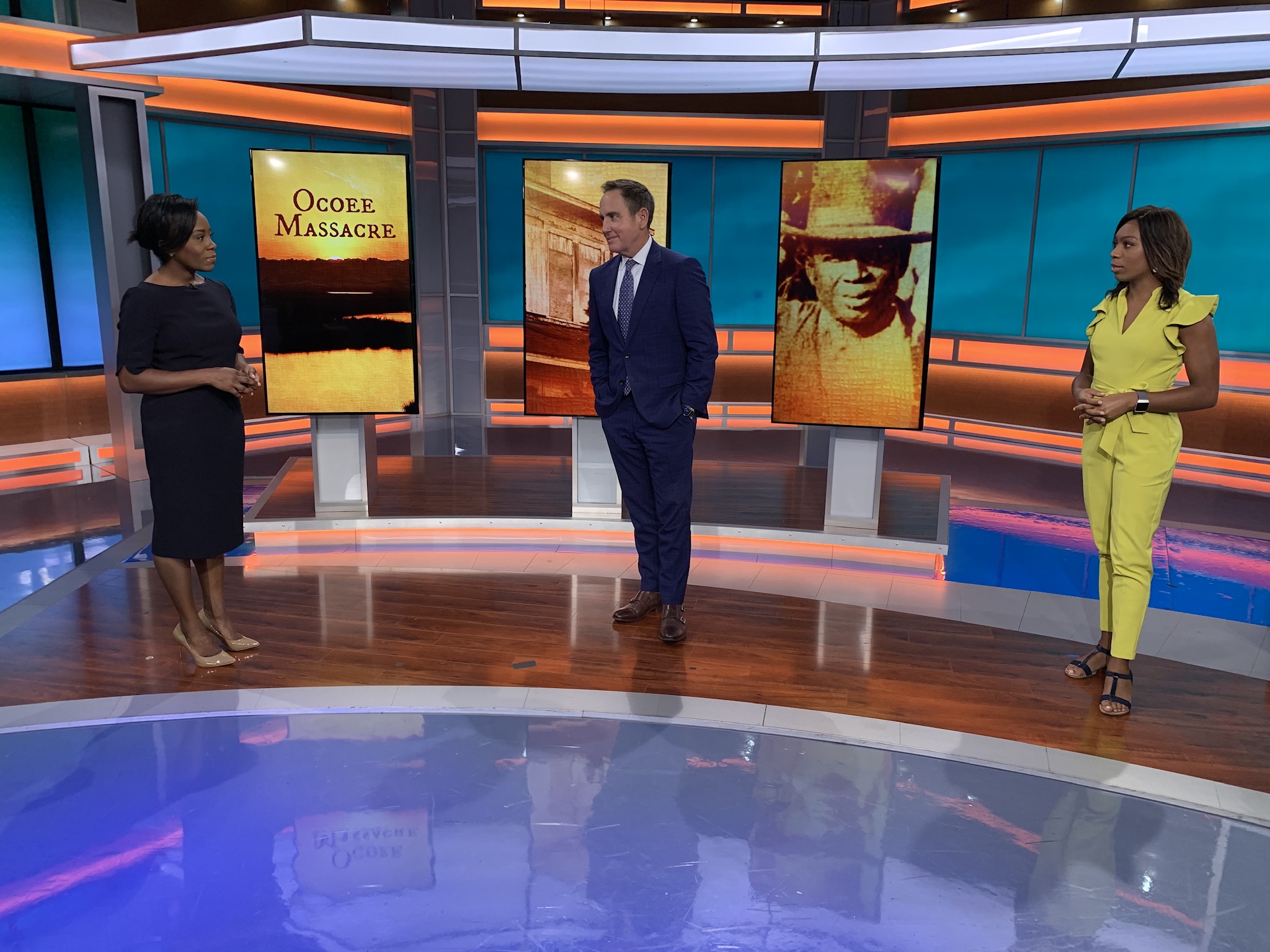In the early 1900s, both the town of Ocoee, Florida, and the citrus business were booming. Hundreds of Black families moved in to the town outside Orlando. They built homes, businesses and lives.
It wouldn’t last.
On Nov. 2, 1920, a prominent Black resident who’d paid the poll tax tried to vote in the presidential election. After a dispute about his right to vote, white residents led a massacre killing an unknown number of people, burning down houses of Black residents and lynching resident July Perry. Hundreds of Black citizens either were killed or left town. One hundred of them owned land that was sold off. They were never paid.
After that, Ocoee didn’t have a thriving Black community for generations.
Daralene Jones, an anchor and reporter at WFTV in Orlando, knew nothing about this history when she and her husband bought property in Ocoee five years ago to build a house. After reading about the Great Migration, she saw mention of the town and started collecting bits and pieces of what happened.
Then, earlier this year, a local lawmaker pushed for that history to be taught and to get reparations for descendants of the massacre.
Like local journalists in Tulsa, Charleston and Tampa, Jones decided it was time to understand what really took place 100 years ago in Ocoee.

July Perry was a labor broker in Ocoee, Florida, until he was lynched following the 1920 presidential election. (Courtesy: Pam Grady, July Perry Foundation)
Local TV stations don’t often produce documentaries, podcasts and multimedia projects all at the same time. The drumbeat of daily news makes that nearly impossible.
But Jones knew this story had to be told differently.
This summer, she started building a team of 15 people from the newsroom and its owner, Cox Media Group. She worked as executive producer and kept a binder full of research. Each interview, each source, led to another. The team worked remotely, while covering daily news and the 2020 presidential election.
Their deadline was the massacre’s 100th anniversary in November.
Reporters conducted dozens of interviews with residents, descendants, politicians and historians. The descendants’ voices are among the oral history, passed down from family to family, that tell what really happened that day.
Jones wanted them to tell their stories in their own way, with their own words. There was no script.
And when the station got an hour, instead of 30 minutes, for the documentary to air in prime time, she felt the pressure.
“These descendants were counting on us to tell their story,” she said. “As a result, I felt pressured to make sure I got it right. I still have to live here. I have to raise three children here.”
Ocoee’s mayor resisted speaking to the station for months, Jones said, and finally agreed after the team conducted more than two dozen other interviews. He’d grown up in Ocoee. His wife was the descendant of the man who some say deputized the white citizens who attacked the Black citizens.
In the interview, he insisted he would never apologize for what happened. He wasn’t there. The city wasn’t responsible.
The Sunday before the election, the documentary aired.
Two days later, on election night and the 100th anniversary of the massacre, Ocoee’s city leaders issued a formal letter of apology.
Jones cried, called her sources, and kept working.
RELATED: Why the Tulsa World is reminding its community of an awful, unspoken past

Reporter Karen Parks, right, interviews historian Francina Boykin, left, a founding member of the Democracy Forum. The local group started in late ’90s to seek answers about the election day massacre. (Courtesy: Daralene Jones)
What happened in Ocoee isn’t just history.
Jones knows it matters to the descendants of the white and Black families who lived there. She’s heard from both. And it matters for the communities working to understand our past and our present.
She is talking now with several area school districts about including the documentary as part of their digital curriculum, but she doesn’t want this documentary to end up untouched on a library shelf. She’s not just handing it over. She is creating examples for the school boards about how the documentary could be taught and student projects that could result from it.
“This can’t be another 50, 100 years where people don’t know about this,” she said. “And it has to start in the schools.”
The documentary and multimedia project marked a first for Cox newsrooms, said Katy Camp, a digital content manager. It was also a first for the journalists involved who worked long days and weekends and with techniques and tech they’d never used before.
From the grind of the pandemic to covering a contentious election, “this has been an incredibly difficult year for our profession,” Camp said
But working together to tell the community what happened there 100 years ago was a morale booster.
“This is meaningful and this is important and this is a story that needed to be told, especially at this time.”
And they’re not done telling it.
Jones would like to pursue a book project about the massacre, and she’s following legislation around reparations for Ocoee descendants, who were never paid for their land.
Her recent reporting includes this:
“It’s believed at least 24 families owned land, according to the Orange County Regional History Center’s records, making up 42 properties and nearly 400 acres of land, worth more than $8 million today.”

Executive Producer Daralene Jones speaks with WFTV anchor Warmoth and reporter Deanna Allbrittin about what to expect from the documentary. (Photo courtesy Daralene Jones)
Local newsrooms have a responsibility to tell these stories, Jones said.
“If not us, who? And if we’re not bringing these stories forward, we have to ask ourselves as news organizations, why not? What’s keeping us from telling these stories of our community?”
She and her station are not alone. The Orlando Sentinel offered in-depth coverage of the Ocoee Massacre this year. And several other newsrooms continued the work of examining their communities’ histories and their newsrooms’ role in perpetuating white supremacy, including the Los Angeles Times’ examination of its own coverage, The (Charleston, South Carolina) Post and Courier examined its city, and the Tampa Bay Times continuing coverage of lost Black cemeteries. (Disclosure: Poynter owns the Tampa Bay Times and I’m partnering with them on an obituary project.)
The pandemic changed how the Tulsa World covered the 99th anniversary of the Tulsa Race Massacre, said Kendrick Marshall, an assistant editor. But it didn’t change their focus on the heart of the story — the people.
Old documents and historians hold valuable information, but so do the stories passed down in the families of the people who were there — the people most journalists then didn’t listen to.
“Ultimately it’s their stories and their perspectives that will matter most and connect most with readers,” Marshall said.
People want to know what happened in their communities. Local newsrooms can help make that happen. Their work can even build bridges, Jones said.
Several politicians in Ocoee and the state have been divided for years, Jones said. Now, they’re talking about putting together a town hall on race.
“That doesn’t happen if you don’t put these stories on display,” Jones said. “We gave everyone in this community who participated in this project a megaphone, and we gave them a rooftop to stand on top of to tell their stories. That’s what local news organizations need to do, to be a voice for their community.”







